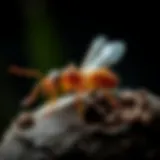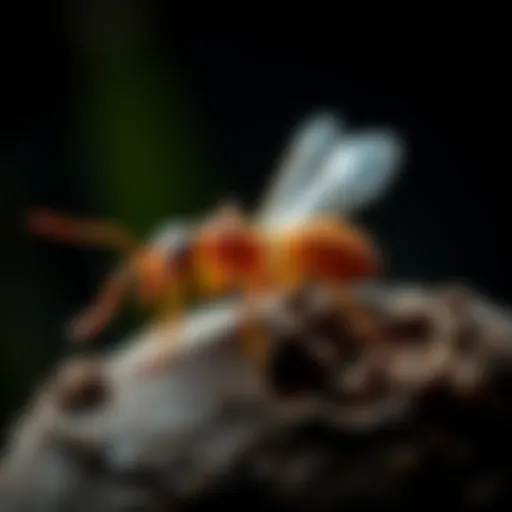Flit Bug Spray: Composition, Use, and Impact


Intro
Flit bug spray has made a mark in the world of pest control, and for good reasons. It is a tool in the arsenal of both agriculture farmers and home enthusiasts. As pesky insects threaten crops and invade homes, understanding how to effectively use this product becomes crucial. From its composition to the safety measures one should take, the nuances of Flit bug spray unfold a rich narrative that underlies its significance in pest management. This article aims to shed light on the intricacies involved with Flit, helping readers navigate through the varying facets of its usage.
Key Concepts and Terminology
In any field, a common language can make all the difference in communication and understanding. When discussing Flit bug spray, certain key terms emerge. Having a clear grasp of these concepts is foundational to making informed decisions about pest control.
Definition of Terms
- Insecticide: A substance used for killing insects. Flit bug spray falls under this category, specifically designed to target a range of pests.
- Active Ingredient: The chemical component in Flit that provides the pest control effect.
- Application Rate: The recommended amount of product to apply per area, ensuring effectiveness without causing harm to the environment or crops.
- Integrated Pest Management (IPM): A strategic approach that combines different management approaches and practices for sustainable pest control.
Overview of Relevant Practices
Understanding the context of how Flit bug spray fits into pest control practices can illuminate its role in both agricultural and domestic settings.
- Targeted Application: Instead of blanket spraying, pinpointing areas where pests are prevalent can prevent unnecessary chemical use.
- Timing: Applying Flit during peak pest activity hours for maximum effectiveness is a practice that many seasoned farmers follow.
- Safety Precautions: Using personal protective equipment (PPE) such as gloves and masks can safeguard users from exposure.
Current Trends and Innovations
Pest management is a field that continually evolves, and Flit bug spray is no exception. Staying informed about the latest developments ensures that users are equipped with the best strategies available.
Latest Research and Developments
Research in pest control has seen innovative strides in various directions. Recent studies have emphasized the importance of organic and eco-friendly insecticides that minimize environmental impact while maintaining efficacy. Exploring such alternatives may guide users toward sustainable practices.
Emerging Technologies and Tools
Advancements in technology also play a role in how Flit and similar products are administered.
- Drone Spraying: Some farmers are now utilizing drones for precision spraying that not only optimizes pesticide use but also enhances targeting and reduces drift.
"Innovation in pest control is not just about new chemicals, but also smarter application methods that shape the future of agriculture."
Practical Applications
To put knowledge into action, understanding how to effectively use Flit bug spray is paramount.
Step-by-Step Guides
Using Flit bug spray can be a straightforward process when broken down into steps:
- Identify Insect Presence: Look for signs of pest infestation, such as wilting plants or visible insects.
- Read Instructions: Always check the label for specific directions on usage.
- Prepare the Area: Clear the area of other plants or obstacles that might be affected by the spray.
- Wear Protective Gear: Gloves and a mask should be standard attire when applying insecticides.
- Apply Flit: Use a sprayer to evenly coat the affected areas, aiming for coverage without over-saturation.
- Monitor Effects: Observe the area post-application for improvements or possible reactions.
Troubleshooting Common Issues
Even the best-laid plans can hit a snag. Here are a few common issues and solutions:
- Ineffectiveness: If pests persist, it may be due to incorrect application or timing. Reassess whether the application rate adhered to guidelines and whether reapplication is necessary.
- Environmental Concerns: If nearby vegetation shows signs of distress, consider revising your application method or trying a different pest management strategy.
Through understanding Flit bug spray, farmers and enthusiasts can make informed choices that lead to effective pest control while considering their environmental footprint. This comprehensive exploration aims to embolden readers with the insights they need to navigate the complexities of pest management.
Prolusion to Flit Bug Spray
In the realm of pest control, Flit bug spray stands out as a stalwart ally for both householders and agricultural producers. Understanding the nuances of Flit is fundamental—it's not just about spraying to kill bugs; it reflects broader themes about health, safety, and effectiveness. For farmers and gardening enthusiasts, mastering the use of Flit can lead to healthier crops and, ultimately, higher yields. Likewise, for homeowners, it can mean a more comfortable living space after battle with unwelcome critters.
What is Flit Bug Spray?
Flit is a brand of insecticide that has been utilized for decades, renowned for its efficacy against a broad spectrum of pest species. It offers a solution to a myriad of pest challenges, whether in the garden or within the home. The formulation typically contains both active and inert ingredients designed to provide a quick knockdown effect against insects on contact. Many users are drawn to Flit not only for its performance but also for the convenience it affords in pest management. Leveraging a well-known name often lends a measure of confidence; after all, who doesn’t want to wield a well-trusted weapon against nuisances?
Historical Context of Flit Bug Spray
Flit's history stretches back to the early 20th century, reflecting significant advancements in agricultural science and technology. Originally developed during a time of rising public health concerns regarding disease transmission by insects, it quickly gained traction as a necessary tool in both urban and rural settings. The evolution of Flit mirrors changes in pest management practices, highlighting society's shifting priorities toward more sustainable and effective solutions.
Throughout its history, Flit has been a focal point in the discussions revolving around pesticide use and safety. It has weathered criticism and praise alike, shaped by the changing perceptions of chemical insecticides over the years. In certain periods, concerns over environmental impacts and health risks have led to increased scrutiny, prompting manufacturers to refine the product and address these valid apprehensions.
In essence, Flit bug spray offers a glimpse into the complex interplay between innovation, necessity, and societal responsibility. While employing such products, it's crucial to remain informed, which will ultimately lead to more responsible usage aligned with modern agricultural and ecological principles.


Chemical Composition
Understanding the chemical composition of Flit bug spray is crucial for grasping its functionality, efficacy, and safety. The way these chemicals interact defines not only how well Flit works against pests but also how they impact the environment and human health. This section delves into the specific elements within the spray, highlighting the active and inert ingredients that contribute to its overall effectiveness.
Active Ingredients
Active ingredients are the primary components of Flit bug spray that directly contribute to pest control. A few key players in this category are pyrethroids, which are synthetic chemicals mimicking natural insecticides derived from chrysanthemum flowers. These compounds, such as permethrin and cyfluthrin, are known for their rapid knockdown effects on various insects, making them popular choices in both agricultural and residential settings.
When effectively utilized, these active ingredients can significantly reduce pest populations. Unlike some traditional insecticides, pyrethroids have relatively low toxicity to humans and pets, which adds an extra layer of appeal for their use in home environments. However, it's essential to remember that while they are effective, over-reliance can lead to resistance in pest populations, diminishing their efficacy over time.
Another notable active ingredient you may find in Flit is piperonyl butoxide. This component enhances the potency of the primary insecticides by inhibiting certain enzymes that pests use for detoxification. In simpler terms, it makes the insecticides work harder, which is particularly beneficial when dealing with pests that have developed some resistance to chemicals.
Inert Ingredients
Inert ingredients may sound unimportant, but don't let the name fool you. These substances, which don't directly target pests, play a vital role in the overall performance of the spray. Examples include solvents and surfactants that assist with the proper application and distribution of the active ingredients.
For instance, water is typically used as a solvent. However, the addition of certain surfactants, like polyethylene glycol, helps the spray adhere better to plant surfaces, maximizing contact with pests. Without these inert ingredients, the effectiveness of the active components could be severely compromised.
It's also worth mentioning that some inert ingredients may have environmental implications. While they do not possess the insecticidal properties, their safety and effects on non-target organisms such as bees or aquatic life can be a concern. Therefore, understanding these components ensures users are informed about the complete package they're working with, enabling safer and more effective pest management strategies.
Overall, the balance of curative and inert elements makes Flit a formidable option in pest control. For farmers and enthusiasts alike, recognizing the significance of these ingredients aids in informed decisions regarding the use of this tool in both agricultural and domestic contexts.
Effectiveness Against Pests
The effectiveness of Flit bug spray in pest control is a crucial topic that resonates heavily with both agricultural farmers and enthusiasts. Understanding how well a pesticide works against various pests not only informs purchasing decisions but also influences broader management strategies in both farms and homes. The main goal, after all, is to keep crops healthy and living spaces pest-free, which can save time and money in the long run.
Target Pest Species
Flit bug spray targets a variety of pests that wreak havoc in agricultural settings and households. Notably, these include:
- Aphids
- Cockroaches
- Flies
- Ants
- Termites
The aforementioned pests are notorious for causing significant damage to crops and can create unhealthy living environments. Aphids, as small as they are, can multiply rapidly, leading to stunted growth of plants. On the other hand, cockroaches are not just an eyesore; their presence indicates unhygienic conditions that may pose health risks. And let's not forget ants, which can form trails that disrupt daily activities, or termites, whose appetite for wood can lead to structural damages.
The ability of Flit to effectively neutralize these pests makes it a valuable tool for maintaining agricultural productivity and residential safety. Farmers often rely on it to ensure that their crops grow unimpeded. Meanwhile, households benefit by achieving noticeable reductions in pest populations, which contributes to overall peace of mind.
Comparative Efficacy
When examining the comparative efficacy of Flit bug spray, it’s important to understand how it stacks up against other insecticides on the market. Factors like speed of action, residual effectiveness, and the breadth of its pest control capabilities play a critical role.
- Speed of Action:
Flit generally acts faster than many alternatives, showcasing noticeable results shortly after application. For instance, while some products might require repeated applications, Flit often provides immediate relief from pest issues. - Residual Effectiveness:
Another critical point of comparison is how long it continues to work after being applied. Flit may offer prolonged residual protection, reducing the number of times a farmer or homeowner would need to spray. This is particularly advantageous during peak pest seasons, when multiple reapplications can be tiring and costly. - Versatility:
Flit showcases a significant versatility, as it doesn’t only target one type of insect; rather, it effectively caters to multiple pests, thus streamlining the pest management process.
However, it’s worth noting that with efficacy comes the responsibility of usage. Over-reliance on any single product can lead to resistance among pest populations. It's wise to rotate insecticides and embrace integrated pest management practices to maintain the effectiveness of solutions like Flit.
"When it comes to pest control, understanding effectiveness isn't just about choosing a spray; it’s about adopting a holistic approach that includes careful timing, multiple strategies, and a deep understanding of pest behavior."
Application Methods
When discussing the use of Flit bug spray, understanding the application methods is crucial. It’s not just about spraying a chemical and hoping for the best; knowing the right techniques can mean the difference between effective pest control and a more complicated problem. These methods can affect not only the spray's effectiveness but also the safety of the environment and the people using it. Proper application helps maximize outcomes and minimize adverse effects, which is a win-win all around.
Use in Agriculture
In the field of agriculture, Flit bug spray plays a pivotal role. Farmers rely on it to protect their crops from various pests which can lead to significant damage if left unchecked. The guidelines for using Flit in farming often emphasize the timing of application. For instance, spraying before an infestation can act as a preventative measure, saving crops from potential devastation. Moreover, certain pests are more active during specific times of the day, making timing critical in the effectiveness of any treatment.
Additionally, compatibility with other pest control methodologies within Integrated Pest Management (IPM) is essential. Farmers should consider the potential impact on beneficial insects, such as pollinators, to avoid unintentional harm. Educating farmers about the seasonality of pest populations and tailoring their spraying strategy accordingly can significantly enhance productivity in agriculture.
Residential Applications
Using Flit bug spray in residential settings might seem straightforward, but there’s more than meets the eye. Homeowners typically need to address the types of pests prevalent in their areas, which could range from ants to mosquitoes. Proper application ensures safety for family and pets, emphasizing that spray should be applied when they are out of the home or in distinct sections of yards. It's often advisable for people to wear protective gear such as gloves or masks during application to avoid skin contact and inhalation of the chemicals.
Knowing how to target specific areas, like foundations or windowsills, significantly increases the spray’s effectiveness in preventing insect entry. Furthermore, conducting follow-up treatments can help in managing pest resurgence, which is quite common if the initial spray is not thorough enough.
Spraying Techniques
Getting the spraying technique right is the final piece of the puzzle in effectively using Flit bug spray. Variations in application, such as using a hand-held spray versus a larger automated spraying system can affect coverage and efficiency. Mist systems, for example, can effectively create a uniform distribution of the chemical, ensuring all affected areas receive adequate treatment.
Here are some effective spraying techniques:


- Backpack Sprayers: Great for targeting hard-to-reach areas. They allow for precision and control in application.
- Aerial Spraying: Used in larger agricultural settings, but requires careful planning to minimize drift and ensure complete coverage.
- Spot Treatment: This method focuses on localized issue areas, saving on chemicals and reducing exposure risk.
It’s crucial to recognize that proper technique not only wards off pests but also minimizes risks to human health and the environment. An informed approach is integral for achieving successful outcomes in pest management.
Overall, application methods for Flit bug spray encompass more than merely the act of spraying; they involve thorough understanding and strategic planning. By considering how and when the product is used, both farmers and homeowners can improve their pest control efforts, reduce potential drawbacks, and contribute to a healthier environment.
Health and Safety Precautions
When it comes to using Flit bug spray, understanding health and safety precautions is crucial not just for users, but for everyone around them. In the world of pest control, effective strategies must always be coupled with a mindset geared toward safety. This part of the discussion addresses not only how to protect oneself but also the broader implications on health for agricultural workers, families, and pets.
Personal Protective Equipment
Dressing the part can make all the difference when applying any pesticide, including Flit. Personal Protective Equipment (PPE) is a must. It’s not fancy gear but practical items that can significantly reduce exposure to hazardous chemicals. Key pieces to consider include:
- Gloves: Nitrile or rubber gloves are essential to keep chemicals from seeping through to your skin. Remember, a thin layer of liquid can easily lead to irritation or worse.
- Masks: A fitted respirator or a simpler mask can help prevent inhalation of airborne particles. Even the lightest inhalation can pose a risk, especially for those with respiratory conditions.
- Goggles: Protect your eyes like you would a priceless jewel. Chemicals can cause serious damage; hence, goggles are a smart addition to your kit.
- Protective Clothing: Long-sleeved shirts and long pants provide an added layer of defense. If available, consider using specially-designed chemical-resistant suits.
- Boots: Don't let your feet hang out to dry; wear sturdy, waterproof boots to maintain protection from overspray or drips.
While applying Flit, donning this gear may feel cumbersome at times, but it is a small price to pay for safeguarding one’s health. Ultimately, ‘an ounce of prevention is worth a pound of cure’ resonates well in these scenarios.
First Aid Measures
Even with the utmost precautions, accidents can happen. Understanding first aid measures is equally essential as using protection gear. In case of exposure to Flit bug spray, knowing how to react can prevent serious health issues. Key first aid measures include:
- Inhalation: If someone accidentally inhales the spray, immediately move the person to fresh air. If symptoms like coughing or trouble breathing persist, seek medical attention.
- Skin Contact: Should Flit come in contact with skin, wash the area thoroughly with soap and water. If irritation continues or a rash appears, consult a physician without delay.
- Eye Contact: Rinse eyes gently with water for several minutes. If there are contact lenses, remove them after the first few minutes and continue rinsing. Persisting symptoms require professional medical help.
- Ingestion: For cases of ingestion, do not induce vomiting unless specifically directed to do so by medical authorities. Instead, call a poison control center or proceed to an emergency room.
Important: Keep emergency numbers and information nearby at all times during spray applications. This preparedness can save precious moments in crisis situations.
Keeping health and safety at the forefront of any pest control operation isn’t just about following set standards; it’s about ensuring sustainable practices that protect not just the individual using the product but also those affected by it. knowledge is power, and understanding how to use Flit safely is integral to effective pest management.
Environmental Impact
The topic of environmental impact is critical in discussions around Flit bug spray because it highlights not only the effectiveness of the product but also its potential consequences on the ecosystems in which it is applied. When farmers and gardeners reach for a pest control solution, the implications for the surrounding environment, wildlife, and beneficial insects cannot be overlooked. Therefore, a holistic understanding of Flit bug spray involves examining its ecological footprint, mitigating risks, and exploring sustainable practices.
Ecotoxicology of Flit
Ecotoxicology is the study of how chemicals affect the health of ecosystems. As Flit bug spray is primarily composed of synthetic chemical compounds, its application raises important questions regarding its toxicity to non-target species, such as pollinators or aquatic organisms. Studies show that certain ingredients in Flit can be harmful to bees and other pollinators that are vital for crop production and biodiversity.
Furthermore, when rain falls after application, Flit can wash into waterways, posing risks to aquatic life. Observations have indicated that fish populations can be significantly impacted by pesticide runoff. Understanding the ecotoxicological effects of Flit involves assessing its long-term persistence in the environment and its bioaccumulation in the food chain.
"The relationship between pesticide application and ecological health cannot be underestimated; it is a delicate dance that requires awareness and responsibility."
Farmers should be aware that while Flit may effectively control pests, its negative repercussions may undermine the ecological balance. It's valuable to conduct routine environmental risk assessments and utilize integrated approaches that complement Flit applications with safer alternatives.
Regulatory Considerations
The use of Flit bug spray is governed by various regulations intended to protect human health and the environment. Regulatory bodies closely monitor the ingredients and acceptable usage levels for different regions. This ensures that, when used according to guidelines, Flit can be applied responsibly without causing undue harm.
In the United States, for instance, the Environmental Protection Agency (EPA) assesses the safety of pesticides. Farmers are encouraged to familiarize themselves with the EPA's guidelines, which can be accessed on epa.gov. Beyond safety evaluations, these regulations also address the appropriate application methods, timing, and necessary precautions.
On an international scale, different countries have launched initiatives to either restrict or promote the use of specific pesticides based on local ecosystems. For instance, the European Union has a more stringent approach toward pesticide registration and usage than some other regions, focusing largely on toxicity to non-target organisms and overall environmental effects.
Integrated Pest Management
Integrated Pest Management (IPM) represents a nuanced approach to pest control that emphasizes the synergy between various strategies and practices. This system takes into contemplation the complex relationships between pests, their natural enemies, the environment, and human intervention. Using IPM means adopting a thoughtful and informed strategy that doesn't rely on a single solution, but rather a variety of tactics tailored to specific pest issues.
Role of Flit in IPM
Flit Bug Spray finds itself as a significant player in the IPM framework. Its application does not act as a standalone measure but better serves as one component in a broader strategy aimed at sustainable pest management.
- Targeted Use: Flit is particularly effective against specific pest species like mosquitoes and various agricultural pests. This targeted action ensures that the impact on non-target organisms—beneficial insects and other wildlife—is minimized.
- Timing and Monitoring: Utilizing Flit correctly requires understanding the life cycle of the pests. Regular monitoring can help farmers determine the optimal moments to apply Flit, which boosts its effectiveness while conserving beneficial organisms.
- Compatibility with Other Tactics: When used in conjunction with biological control and habitat management practices, the overall ecological balance is better preserved. For instance, applying Flit to deal with an emerging invasive pest while also introducing native predators can yield a more resilient ecosystem.
Complementary Practices
To truly harness the potential of Flit within an IPM framework, it must be complemented with other control measures. Here are some complementary practices that enhance IPM strategies:
- Crop Rotation: Changing the types of crops grown in a specific area can disrupt the life cycles of pests and reduce their populations over time.
- Utilization of Beneficial Insects: Introducing or fostering natural predators can reduce pest populations without reliance on chemical controls. Ladybugs, for instance, can significantly cut down aphid populations.
- Cultural Controls: Adjusting agricultural practices like planting dates, soil management, and field sanitation can also thwart pest proliferation.
- Pheromone Traps: These can help in monitoring pest populations and can act as a deterrent by attracting pests away from valuable crops.
In summary, while Flit Bug Spray plays a vital role in Integrated Pest Management, its efficacy is markedly enhanced when coupled with these complementary practices. Striking a balance between chemical and ecological approaches ultimately leads to healthier crops and a more sustainable agricultural ecosystem.


"Pest management is not about one tool in the toolbox but a holistic approach that considers every angle."
For further insights and a detailed explanation of Integrated Pest Management, you might find useful resources on Wikipedia.
Another informative site is EPA.
Challenges and Limitations
When discussing Flit bug spray, it is crucial to recognize the challenges and limitations associated with its use. Understanding these elements is essential for farmers and enthusiasts who wish to employ pest control methods judiciously. This relationship between efficacy and potential drawbacks sets the stage for an informed approach to pest management. The following subsections will delve deeper into significant issues such as resistance development and the public perception and usage of these products.
Resistance Development
A pressing concern in pest management is resistance development among target pest species. Over time, as certain insects are repeatedly exposed to Flit bug spray, they can develop resistance to its active ingredients. This phenomenon is not unique to Flit—it's a widespread issue with many insecticides.
This can lead to the following problems:
- Reduced Efficacy: When pest populations become resistant, the effectiveness of Flit diminishes, causing farmers to apply higher dosages or switching to alternative chemicals.
- Increased Costs: The need for more potent treatments or additional pest control methods raises costs for agricultural users considerably.
- Shifting Pest Dynamics: As some pests become resistant, others might fill the void, complicating pest management scenarios.
Addressing this issue requires an integrated approach, where Flit is combined with other pest control measures, ensuring that no single method wears down pests to the point of resistance. However, such strategies demand diligence and can be labor-intensive.
Public Perception and Usage
Public perception plays a significant role in the success and application of Flit bug spray. With growing awareness of environmental issues, many consumers are becoming skeptical about using chemical pesticides, which can influence their effectiveness in the market.
A few key considerations include:
- Safety Concerns: Misunderstandings about the safety of Flit can deter individuals from using it, despite regulatory assurances of its proper use.
- Environmental Awareness: As more people prioritize eco-friendly practices, many are turning away from traditional chemical insecticides, seeking alternatives such as organic solutions or integrated pest management systems.
- Misinformation: Anecdotal evidence circulated on social media can shape public perception, leading to doubts about the necessity or safety of using Flit bug spray in both agriculture and residential settings.
Balancing these perceptions while effectively communicating the benefits of Flit is crucial. Education initiatives that address how to use Flit responsibly could make a significant difference, nurturing a more informed audience.
"Awareness is the first step in fostering effective communication; it's not about changing minds, but rather providing clarity."
Overall, while Flit bug spray remains a potent tool in pest management, its future will greatly depend on navigating resistance development and addressing public perception carefully.
Future Trends in Pest Control
The world of pest control is rapidly evolving, influenced by advancements in technologies and a growing awareness of environmental sustainability. As farmers and enthusiasts grapple with the challenges posed by pests, future trends offer a beacon of hope for those looking to balance effective pest management with ecological harmony. Understanding these trends is crucial for making informed decisions on pest control strategies.
Innovations in Insecticides
In recent years, research has paved the way for significant innovations in insecticides. These developments focus not only on the efficacy against pests but also on the environmental and health implications of their use. Some notable innovations include:
- Microbial Insecticides: These products exploit naturally occurring bacteria, fungi, and viruses that target specific pests. They minimize harm to beneficial insects and the surrounding environment.
- Biopesticides: Derived from natural materials such as plants, fungi, and minerals, biopesticides present a sustainable alternative to conventional chemical insecticides. They often have lower toxicity for humans and non-target species.
- Targeted Delivery Systems: Advances in technology allow for precision application of insecticides. Drones equipped with spraying systems can now target specific areas, reducing waste and minimizing off-target effects.
These innovations reflect an overarching trend towards specificity and reduced ecological impact, inviting farmers to embrace more strategic approaches to pest control.
Sustainable Alternatives
In light of increasing regulatory scrutiny and environmental concerns, sustainable alternatives to traditional pest control methods are gaining traction among agriculturalists. These alternatives include:
- Integrated Pest Management (IPM): This multifaceted approach combines biological, cultural, and chemical methods to manage pest populations. IPM emphasizes long-term prevention and uses natural predators to control pest numbers.
- Companion Planting: Certain plants are known to repel pests or attract beneficial insects. By strategically planting diverse crops together, farmers can create a more balanced ecosystem that naturally deters harmful insects.
- Organic Practices: The shift toward organic farming is a response to consumer demand for products free from synthetic pesticides. Organic farmers use naturally derived pest control methods, focusing on soil health and biodiversity.
Sustainable alternatives not only enhance food safety but also promote a healthier ecosystem. This shift towards more sustainable practices reflects an awareness of the interconnectedness of agriculture, health, and the environment.
In summary, the future trends in pest control revolve around innovative technologies and sustainable practices that reflect society's growing demands for safer, more responsible pest management. Understanding these trends can help farmers navigate a more complex landscape while still effectively managing pests.
Epilogue
The conclusion serves as the final chapter in this exploration of Flit Bug Spray, tying together essential themes covered throughout the article. This section is crucial as it encapsulates the core ideas discussed and emphasizes how they relate to both agricultural practices and residential pest management. Flit Bug Spray is more than just a tool for pest control; it's a representation of ongoing efforts in agricultural innovation and the constant battle against pest resistance. A nuanced understanding of this product can empower users—whether farmers or homeowners—to make informed decisions that prioritize both efficacy and safety.
Summary of Key Points
In reviewing the multifaceted aspects of Flit Bug Spray, several significant points emerge:
- Chemical Composition: Understanding the active and inert ingredients is vital in assessing how Flit works against specific pests and its safety for humans and animals.
- Effectiveness: The ability of Flit to target a range of pests and its comparison with other insecticides highlights its relevance in pest management strategies.
- Application Methods: Different methods of application suit varying environments, from large-scale farming to domestic gardens, enhancing usability.
- Health and Safety Precautions: Personal protective equipment and first-aid measures are not merely suggestions but essential practices when using any chemical product.
- Environmental Impact: Awareness of ecotoxicology and regulatory considerations reflects a growing concern for sustainability in agricultural practices.
- Future Trends: Innovations in insecticides, along with sustainable alternatives, point to an evolving landscape that seeks more effective and safer pest control solutions.
By consolidating these points, readers gain insight not only into how Flit Bug Spray functions but also into the broader implications of pest control methods in today’s environment.
Final Thoughts on Usage
In wrapping up this investigation, the takeaway is clear: Flit Bug Spray offers valuable benefits in both agricultural and residential contexts. However, its use is not without responsibilities. Adopting Flit into pest control strategies should come with a commitment to safety and a keen awareness of environmental impacts.
As pest pressures continue to evolve, integrating Flit into a more extensive framework of Integrated Pest Management practices can enhance its effectiveness while minimizing adverse effects. Balancing immediate pest control needs with longer-term sustainability goals is paramount. It’s recommended that users stay informed about evolving regulations and alternative methods to ensure they can adapt to changing conditions.
"Knowledge is key in pest management, and understanding products like Flit Bug Spray enables smarter choices".
By staying engaged and educated, those involved in agriculture or home gardening can leverage the benefits Flit provides, ensuring that their pest control efforts are effective, safe, and sustainable.







